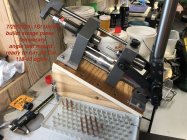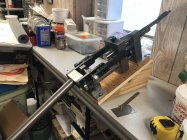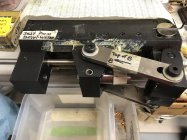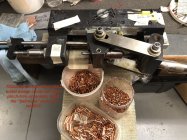Schippergreg
Silver $$ Contributor
Follow along with the video below to see how to install our site as a web app on your home screen.
Note: This feature may not be available in some browsers.
Nice workPresses are pretty much completed. Just need to machine end of ram for punches. I'll do that once I get a set of LR dies. View attachment 1681804
George Ulrich had the ultimate bullet making press on display at the recent score nationals and I failed to take a single picture. How about posting a picture here George and make everyone drool as much as I did.




I spoke with sierra today. I was told that once a jacket order is placed, as soon as they begin the next production of those jackets they fill that order. So, no order deadline but no specific production estimate either.Not yet, waiting on that response.
George's new press looks to be killer good! Can't wait to see it in action, first hand.View attachment 1681903
View attachment 1681904
Thank You, George!Here are some snaps of The Ulrich bullet swage press just set-up and ready to run a few thousand thirty Cal. bullets. George had advised an initial mount angle of 45* - and, "boy was he wrong" . . . until I made it 27.5, only to learn that, 'just maybe', George was/is correct!
That said, the Hood air assisted presses are positioned at about 27.5* - they are a very good, but different animal.
This press is ROCK SOLID, 'SILKY SMOOTH', and with more than adequate leverage - I'll know a lot more following today's 'real work' session. Once i acquire the materials, I'll make an adjustable angle mount. This press will accommodate a wide variety of positioning.RG
P.S. for comparison, here are a couple of the Meister/Ulrich clones of the original B&A swage press (i have & use three of these): for all operations, up to 6mm, these presses are GREAT! For thirty Cal., though very good for core-seating, when it comes to pointing, they are disappointingly short on leverage. View attachment 1681911
View attachment 1681912
GREASE & OIL are your friends . . . except on jackets, where lubrication is a necessary evil.
Liseo, to what and how is your base attached? To the press? RG
Jackie, with your spacer, do you have any 'float' in the punch? -AlOne way I control flex is I have a spacer the is machined for a few thousanths over the punch on the ID and the OD about like the die body. This seats firmly against the bottom of the punch so I am not relying on the linkage. We let the bullet stay in the Point Up Die a few seconds.View attachment 1681959View attachment 1681960View attachment 1681960View attachment 1681959
Sure. The spacer has clearance over the punch.Jackie, with your spacer, do you have any 'float' in the punch? -Al
Liseo, to what and how is your base attached? To the press? RG
Randy/GeorgeLiseo the ram is in the same position for both photos , how and where is the indicator attached if it on the bench and you are checking that wont work

